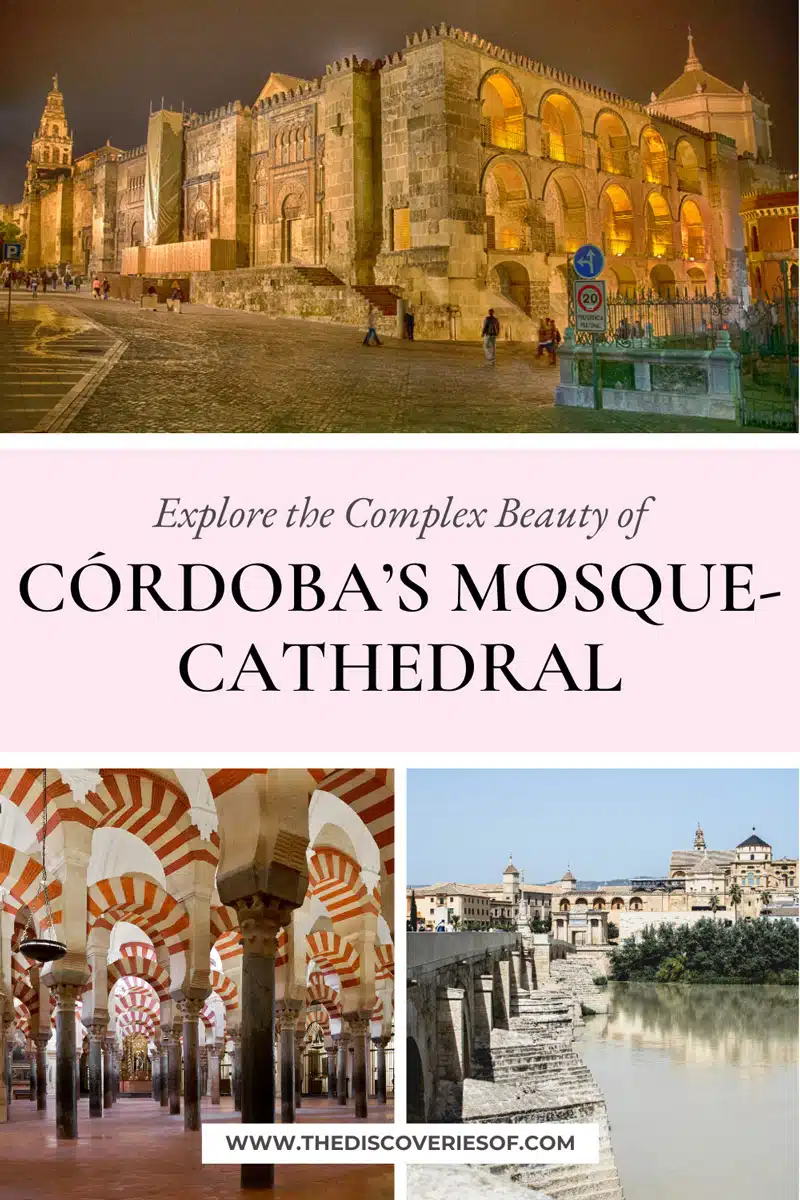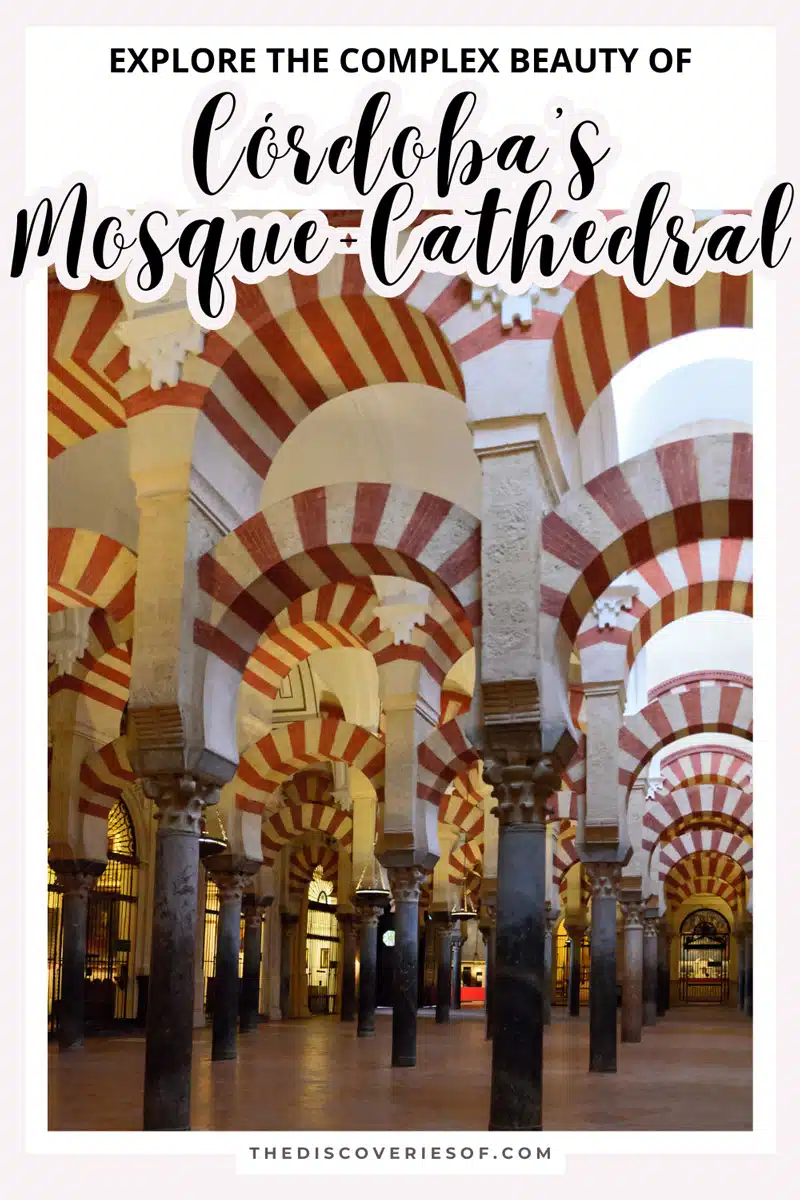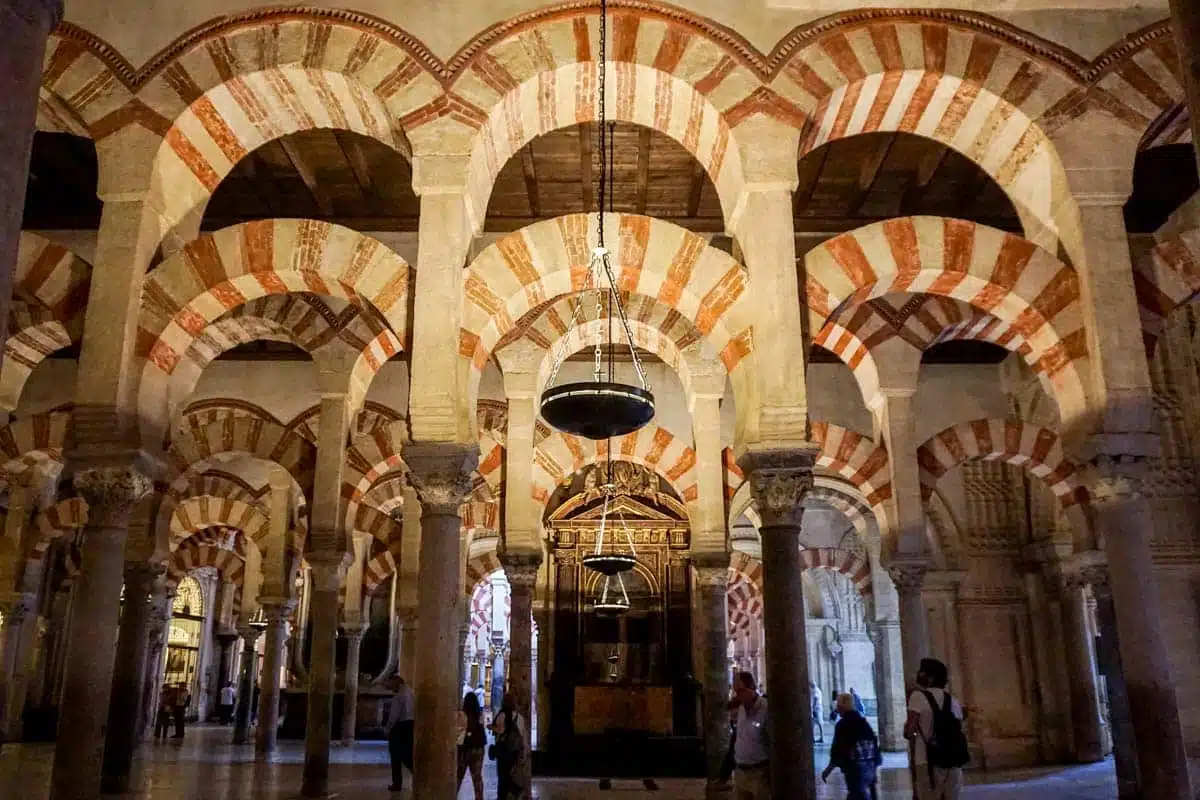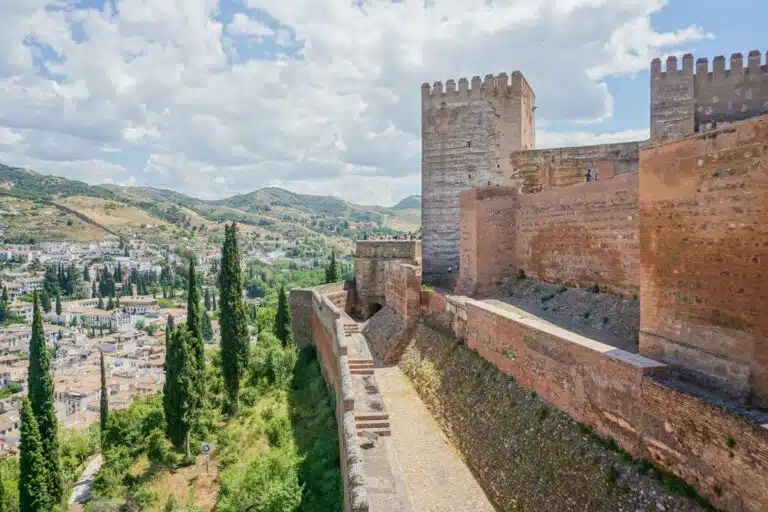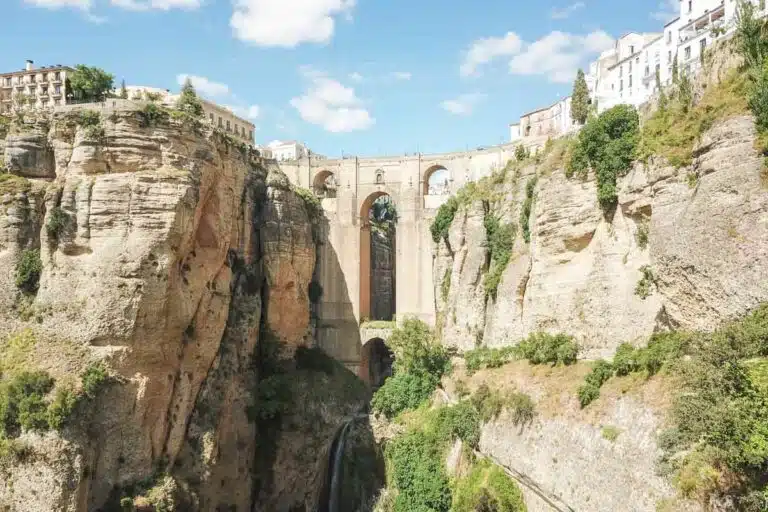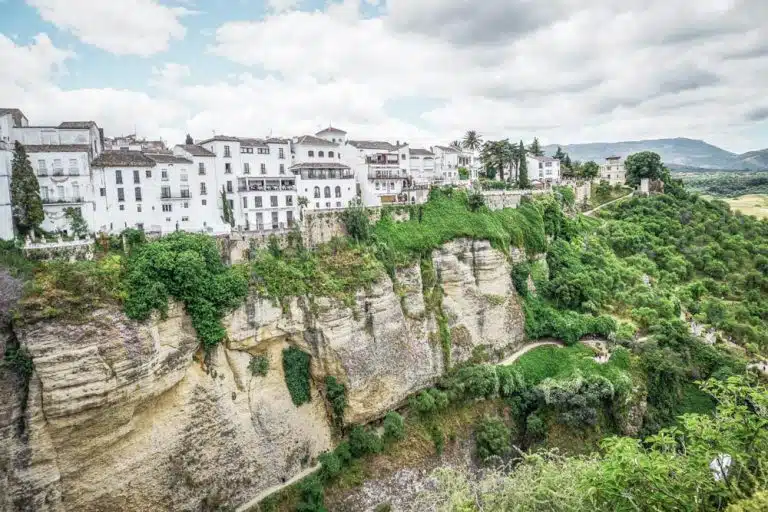The Mosque-Cathedral of Córdoba is one of the world’s most famous landmarks, with a complex past spanning centuries and a stunning architectural design. Discover more about the history, how to tour the site and where to stay when visiting the Mosque-Cathedral of Córdoba.
The Mosque-Cathedral of Córdoba has many names – the Mesquita and the Cathedral of Our Lady of the Assumption being the most popular two – but delve into its history and it has a long tale to tell.
Located in one of the most ancient cities in Spain, the building has numerous features that date back to ancient Roman times.
Don’t worry, though – you don’t need to be a history major to appreciate the importance of this spectacular landmark in Spain. Walk through the towering doors, and you’ll see endless details, large and small, that play key roles in Muslim and Christian faiths.
Ready to learn all about the Mosque-Cathedral of Córdoba? Here’s what you need to know and how to plan your trip.
Why Visit the Mosque-Cathedral of Córdoba?
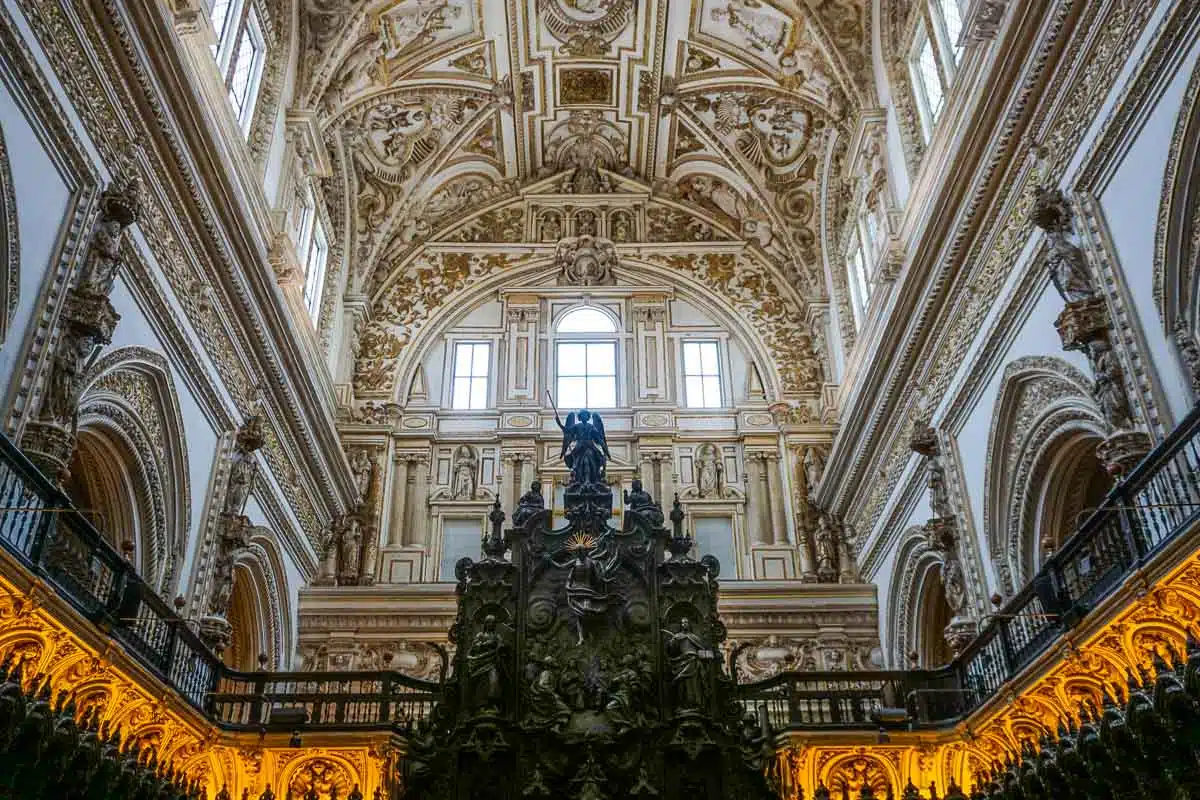
The Mosque-Cathedral of Córdoba was on my bucket list for many years before I finally got to visit. And I’m so glad I did.
Instantly recognisable as a one-of-a-kind building, not only is the Mesquita home to elements of two distinctly different religions, but the architecture and design are simply remarkable down to every intricate detail etched onto the columns and walls.
Simply put, if you’re visiting Europe and plan to spend time in Southern Spain, the Great Mosque at Córdoba must be on your travel plans. The history, architecture and ornate design make it one of the most impressive landmarks in the world.
Planning a trip to Andalusia? Schedule a visit to the Mosque-Cathedral of Córdoba and see why it’s a must-visit location in Spain.
The History of Córdoba’s Mosque-Cathedral
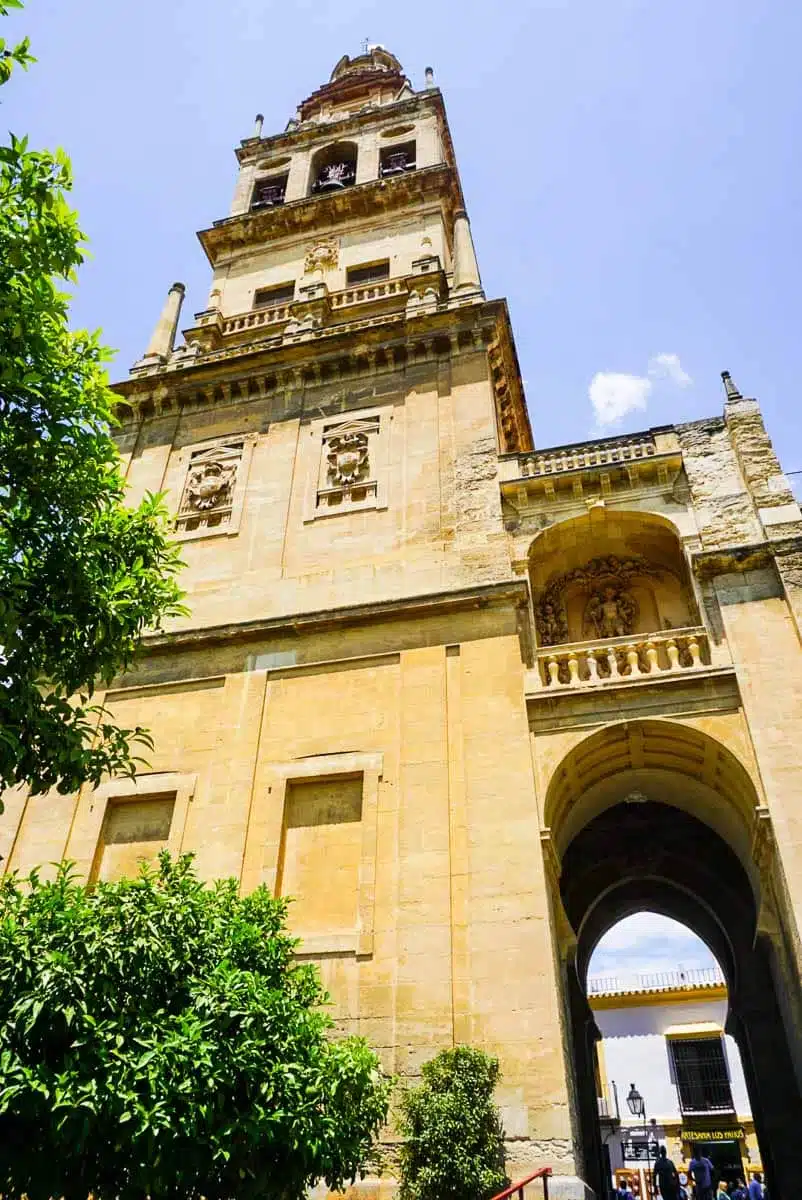
The Mosque-Cathedral has a history as long and intricate as its design. Let’s dive in.
It was built in the 8th Century under Abd ar-Raḥmān. He was one of the last remaining leaders of the Umayyad Caliphate and moved from Damascus to Córdoba, starting a three centuries-long ruling period in Córdoba for the Umayyad dynasty.
Not only did Abd ar-Raḥmān begin revitalising the city of Córdoba through infrastructure, but he began construction on the great mosque of Córdoba.
Numerous additions occurred to the Great Mosque of Córdoba’s history during the Islamic Golden Age. The minaret became the most famous feature on the exterior and stood for centuries as a proud symbol of the Muslim faith.
During the 13th century, in 1236, King Ferdinand III laid claim to Córdoba and began imposing Christian ideology and architecture throughout the city. He immediately announced that the building was a cathedral and no longer a Muslim worship place.
Many of the Moorish treasures, including pieces of the minaret, are believed by some historians to be taken during the final decades of the Umayyad Caliphate before King Ferdinand III ruled Córdoba.
In the 16th Century, Hernán Ruiz III added many of the Gothic and Renaissance influences.
The most famous of all is the Bell Tower, a defining characteristic of the building today. It stands where the minaret used to be and is a clear reminder of the complex history of this historical landmark in Spain.
Córdoba’s Mesquita Today: Key Locations
Patio de los Naranjos (Orange Tree Courtyard)
Outside the Mosque-Cathedral of Córdoba, you’ll find one of the most ancient gardens still thriving in Spain (some say in all of Europe – and I happen to agree).
Today, nearly 100 orange trees lead to the famous mosque-cathedral. You can only walk through this famous courtyard during designated times, so book a ticket early or arrive before opening for fewer crowds.
Arches and Columns in the Prayer Hall
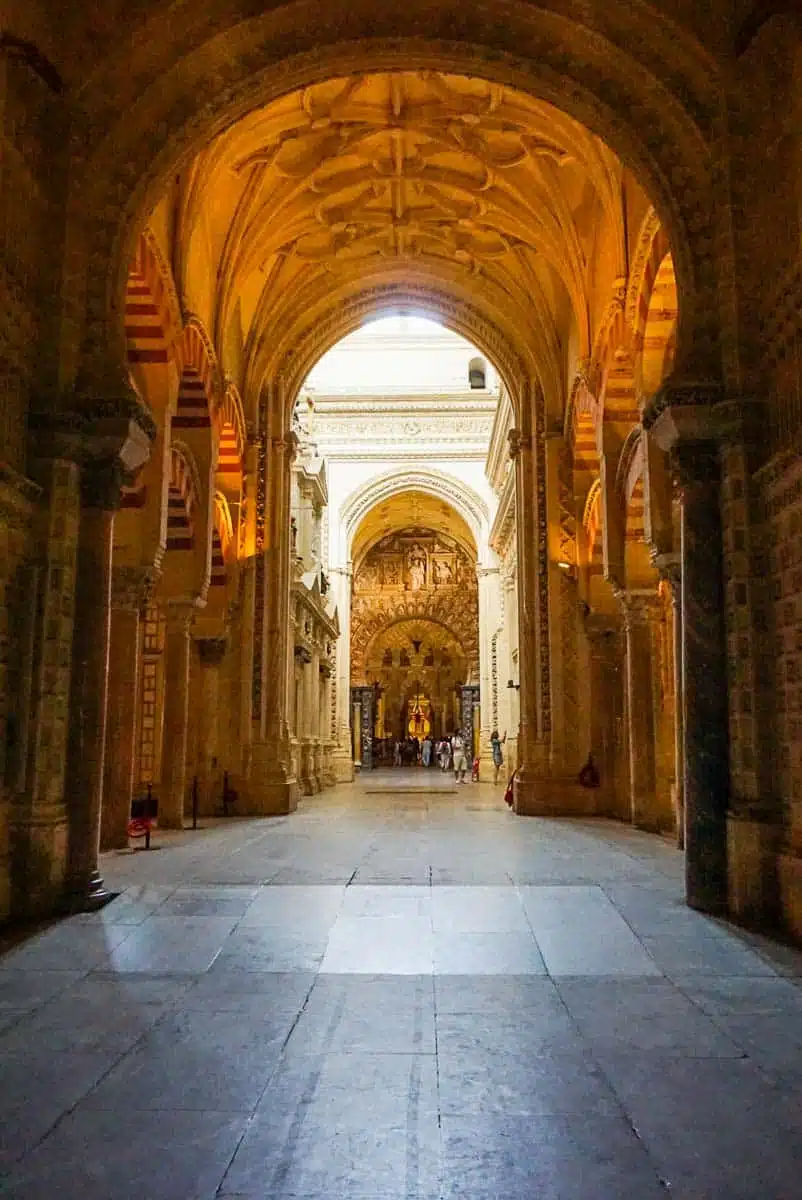
Because the construction took place early in the Umayyad dynasty rule, political pressures forced the quick build of the Great Mosque.
Luckily resources were plentiful, and the ancient Roman ruins around the city helped construct the soaring pillars and horseshoe arches of various bricks and stones that are now among the most famous attributes of the Mezquita de Córdoba.
The Mihrab
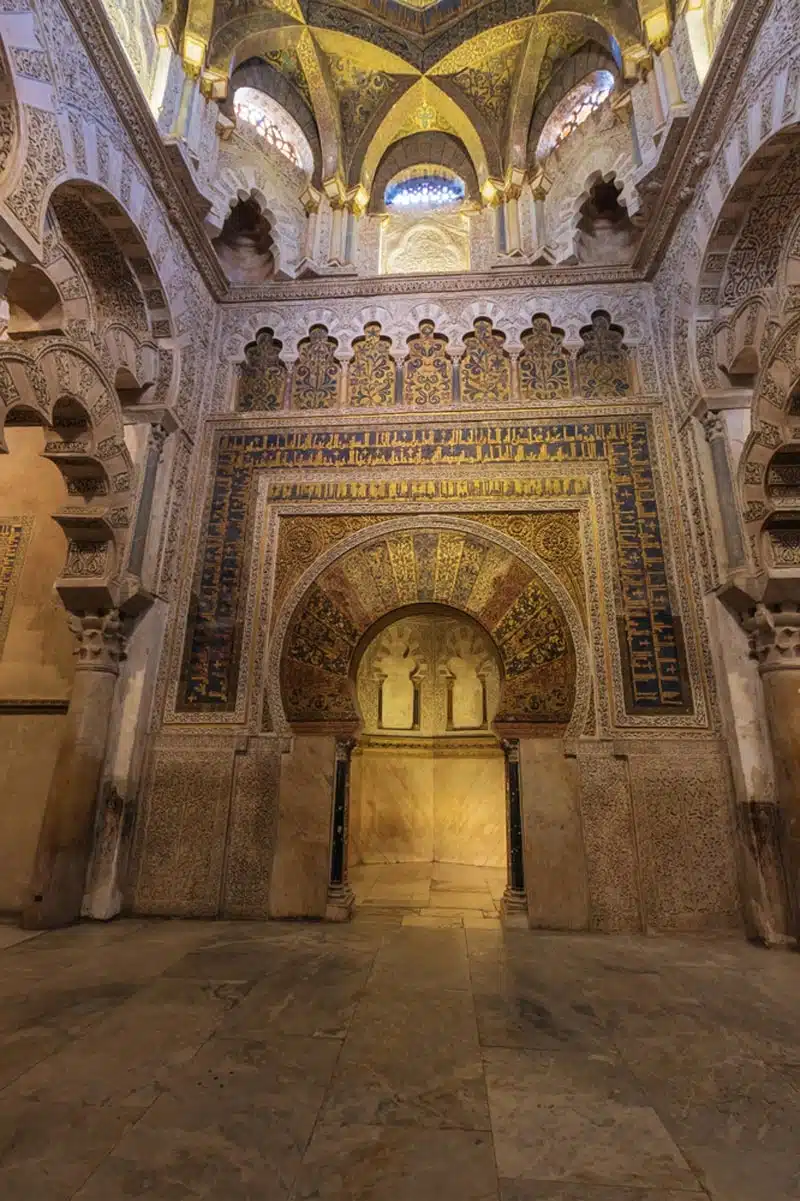
Over the years, during the Islamic Golden Age, the building underwent expansions that added ornate details and extra space to the prayer hall, courtyard, and interior design. The domes and Mihrab are among the most impressive features and are absolutely marvellous.
The focal point of the prayer area, the Mihrab, faces Mecca and instructs where Muslims should direct their prayers. The colourful decoration catches the eye with numerous bright colours intermingling with gold in an elegant display.
Capilla Real (Royal Chapel)
After a few centuries under Christian rule, Gothic and Renaissance features emerged. The Royal Chapel displays elements of Christianity and Spanish influence, and sits side by side within the mosque-cathedral.
This area is not currently open to the public.
Capilla Mayor (Main Chapel)
Hernan Ruiz I built the 16th-century additions to the main chapel around the forest of columns in an attempt to preserve elements of the original construction and the Muslim influence.
Vaulted ceilings display Gothic influence and pay tribute to the Assumption of Our Lady with images of angels, saints and other Christian imagery.
The Bell Tower
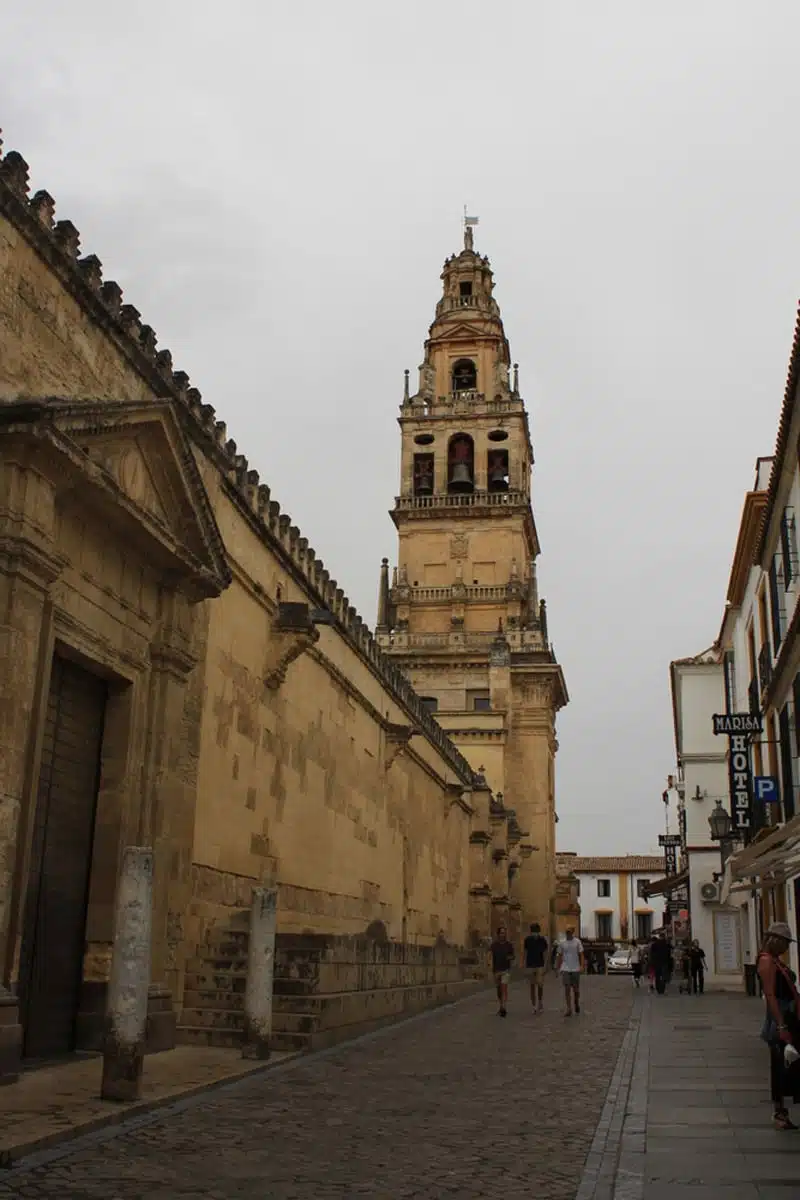
The most famous of the 16th-century additions, The Bell Tower is an amazing architectural site that underwent renovations in the 21st Century by Ruiz’s son and grandson.
Renaissance architecture is a notable feature of the building’s exterior and is worth looking at while visiting. Climb the Bell Tower for a grand view of the city from its highest point.
Planning Your Visit to the Mosque-Cathedral
Mosque-Cathedral of Córdoba
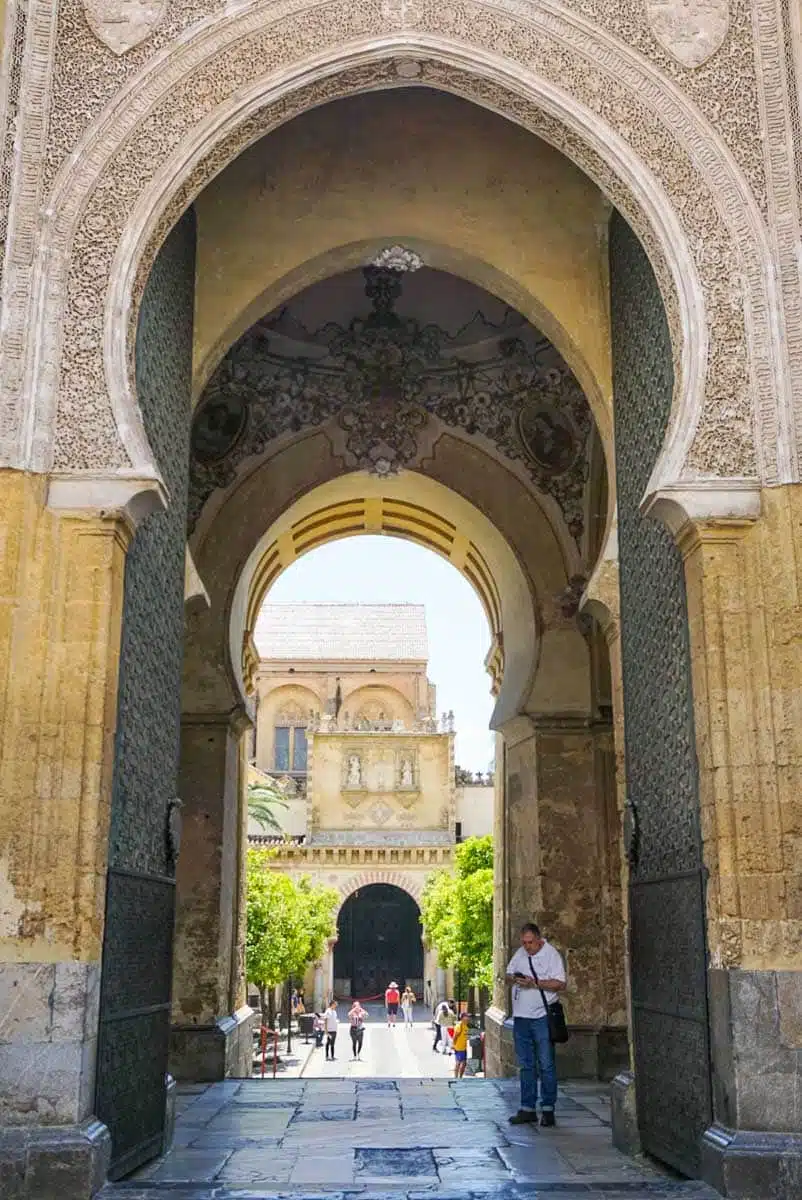
Finding the Mosque-Cathedral of Córdoba is easy once you reach the city’s centre. It’s near the river banks of Guadalquivir, the Roman Bridge of Córdoba, and many of the most famous sites in town.
Need an exact address to plug into your maps? C. Cardenal Herrero, 1, 14003 Córdoba, Spain.
If your phone loses service or you tend to lean more old-school, look for the tallest building in the ancient city. The Bell Tower is over 50 metres high and easy to see from nearly any angle.
Córdoba Mosque-Cathedral Opening Times
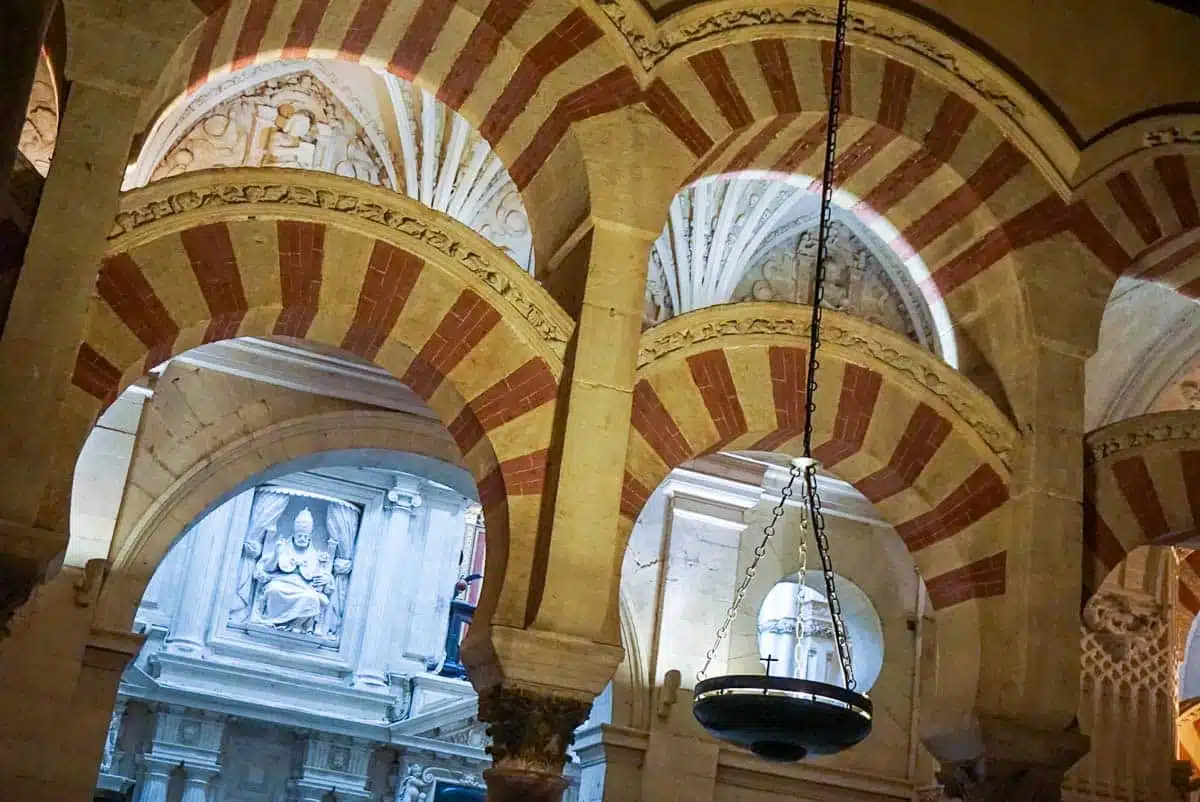
You can visit the Mosque-Cathedral at 8:30 – 9:30 am free of charge. Official access to the bell tower opens at 9:30 am and 10:00 am for the Mosque-Cathedral.
Closing times may vary throughout the year, but the mosque-cathedral is open during the summertime until 7 pm and the Bell Tower until 6:30 pm.
There is now an option for night owls, too. A night tour called “The Soul of Cordoba” has openings throughout the week and is a popular time to see the landmark in a different light.
Visiting the Córdoba Mosque-Cathedral Independently
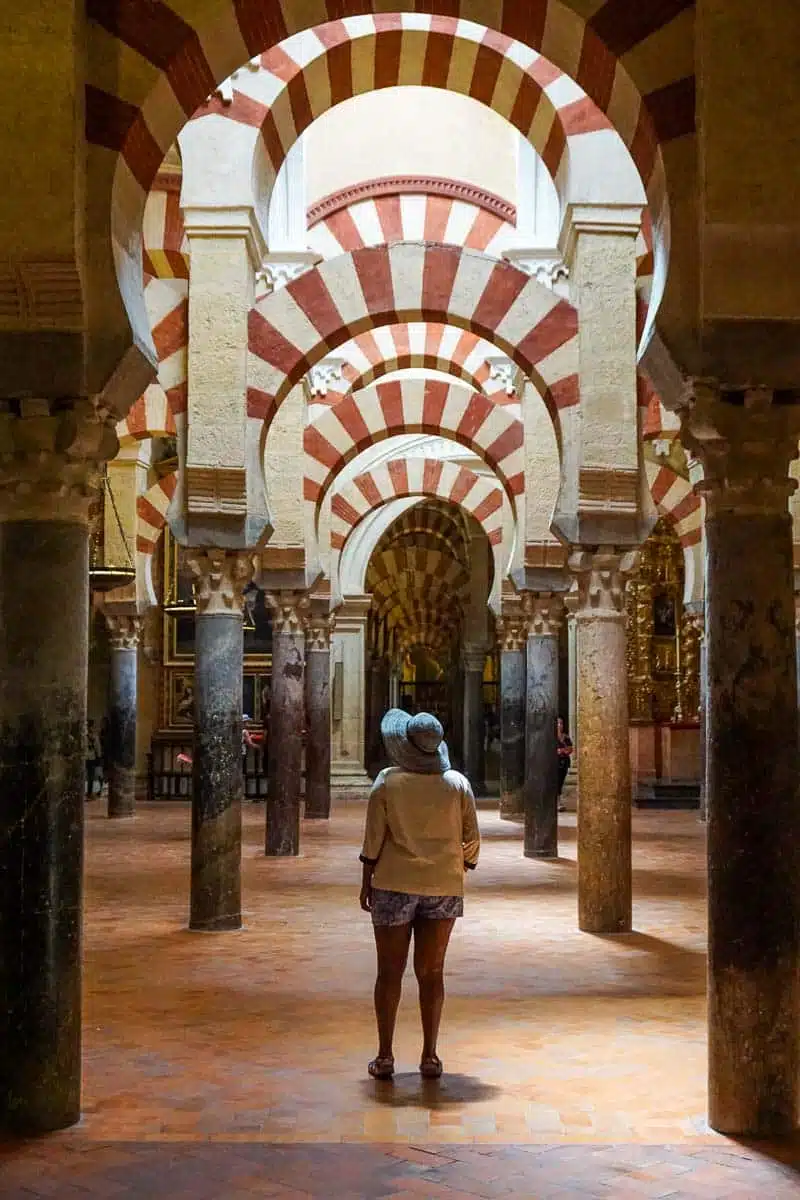
Want to get to the Córdoba Mosque-Cathedral on your own? No problem. Arrange a trip from a nearby city.
Planning a perfect Spain itinerary? You can access the Córdoba Cathedral via high-speed train from Madrid. There are multiple daily trips, and you can get from Madrid to Cordoba in under two hours for around £15 ($20).
You can also hire a car, but it would take nearly twice the amount of time and be much more of a hassle. However, if you’re travelling from smaller cities in Spain, it may be the only option for getting here.
Mosque Cathedral of Córdoba On a Tour
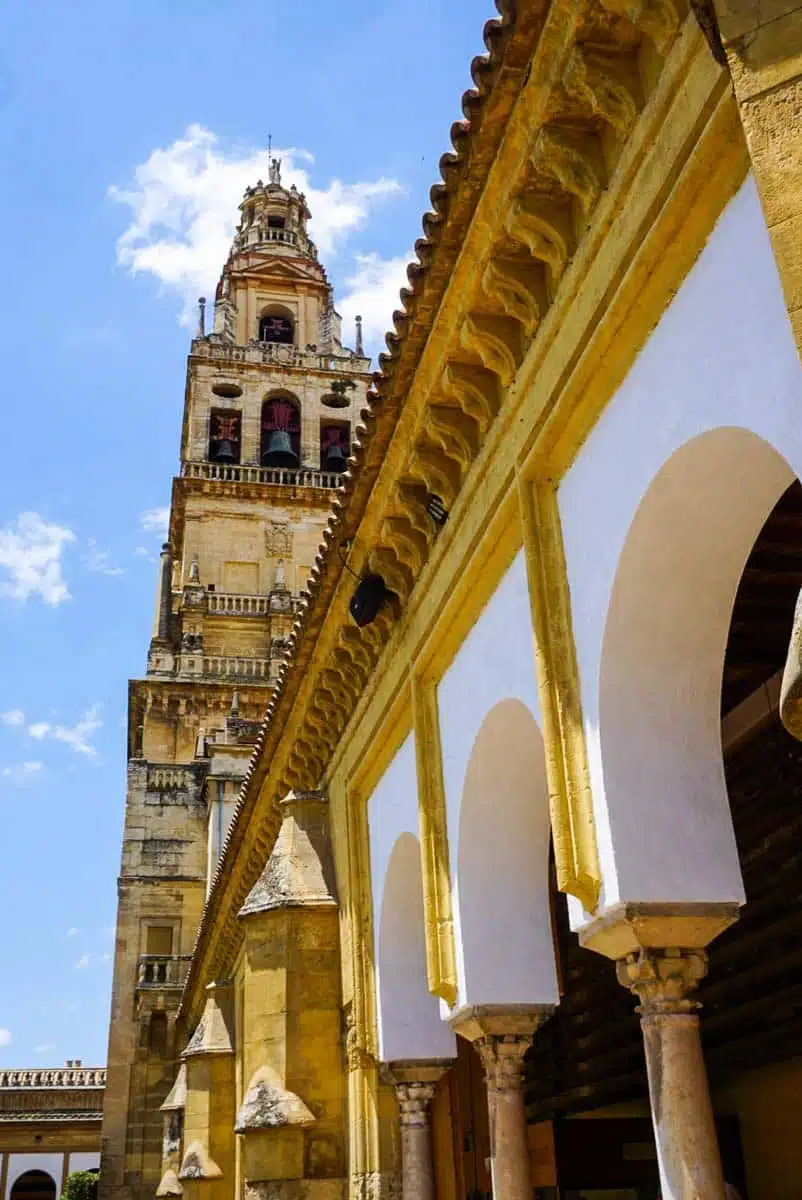
I’m all for seeing Europe’s top landmarks solo whenever possible. And the fact that you can enter the Mosque-Cathedral for free for an hour each day is reason enough to do it.
But to experience such an important piece of world history fully, heading out on an expertly guided tour is a slam dunk option. The problem is, there are a lot of guides who will tell you they’re the best option for seeing the Mosque-Cathedral when you visit Southern Spain.
Luckily, Get Your Guide provides some excellent tours of the Mosque-Cathedral, and they also offer some queue-jumping options.
Try booking this guided tour, and you’ll learn numerous facts about the Mosque-Cathedral from an art historian who will navigate the centuries of history by explaining details you may not have noticed on your own.
Where to Stay for Mosque at Córdoba
Wondering where to stay to see the Mosque-Cathedral in Córdoba? Luckily, many of the best hotels in the city are often within walking distance of the historical site.
Hospes Palacio del Bailio
If you’re looking for the best hotel in Córdoba, look no further than Hospes Palacio del Bailio. This 5-star boutique property sits in a castle dating back to the 16th century.
Walking through the courtyard, you’ll see vines slowly making their way up the ancient facade, and you can’t help but think about the hundreds of years of history within the walls.
That said, the outdoor pool is decidedly modern, with stylish loungers surrounding it. And, inside, you’ll find rooms that have the cavernous grandeur of an ancient palace but modern touches that make the room feel anything but tired.
Service is attentive, amenities are all top-notch and you can walk to many of the most important sites in Córdoba, including the magnificent Mosque-Cathedral.
Alternatively, check all accommodations in Córdoba on Booking.com.
Mosque Cathedral of Córdoba Map
The Mosque-Cathedral of Córdoba: Read Next
Love this? Save and Share on Pinterest!
